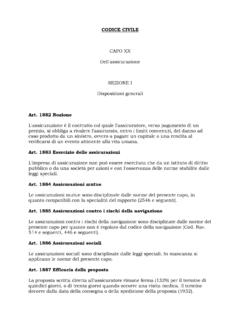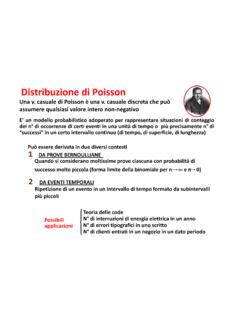Transcription of A Handbook of Statistical Analyses Using R
1 A Handbook of Statistical AnalysesUsingRBrian S. Everitt and Torsten HothornPrefaceThis book is intended as a guide to data analysis with theRsystem for sta-tistical an environment incorporating an implementation oftheSprogramming language, which is powerful, flexible and has excellentgraphical facilities (R Development Core Team,2005). In the Handbook weaim to give relatively brief and straightforward descriptions of how to conducta range of Statistical Analyses usingR. Each chapter deals with the analysisappropriate for one or several data sets. A brief account of the relevant statisti-cal background is included in each chapter along with appropriate references,but our prime focus is on how to useRand how to interpret results. Wehope the book will provide students and researchers in many disciplines witha self-contained means of usingRto analyse their an open-sourceproject developed by dozens of volunteers for more than ten years now and isavailable from the Internet under the General Public becomethelingua francaof Statistical computing.
2 Increasingly, implementations ofnew Statistical methodology first appear asRadd-on packages. In some com-munities, such as in bioinformatics,Ralready is the primary workhorse forstatistical Analyses . Because the sources of theRsystem are open and avail-able to everyone without restrictions and because of its powerful language andgraphical capabilities,Rhas started to become the main computing engine forreproducible Statistical research (Leisch,2002a,b,2003,Leisch and Rossini,2003,Gentleman,2005). For a reproducible piece of research, the originalobservations, all data preprocessing steps, the Statistical analysis as well asthe scientific report form a unity and all need to be available for inspection,reproduction and modification by the readers. Reproducibility is a natural re-quirement for textbooks such as the Handbook of Statistical Analyses UsingR and therefore this book is fully reproducible Using anRversion greater orequal to All Analyses and results, including figures and tables, can bereproduced by the reader without having to retype a single line ofRcode.
3 Thedata sets presented in this book are collected in a dedicated add-on packagecalledHSAUR accompanying this book. The package can be installed fromthe ComprehensiveRArchive Network (CRAN) viaR> ("HSAUR")and its functionality is attached byR> library("HSAUR")The relevant parts of each chapter are available as avignette, basically adocument including both theRsources and the rendered output of everyanalysis contained in the book. For example, the first chapter can be inspectedbyR> vignette("Ch_introduction_to_R", package = "HSAUR")and theRsources are available for reproducing our Analyses byR> edit(vignette("Ch_introduction_to_R", package = "HSAUR"))An overview on all chapter vignettes included in the package can be obtainedfromR> vignette(package = "HSAUR")We welcome comments on theRpackageHSAUR, and where we think theseadd to or improve our analysis of a data set we will incorporate them intothe package and, hopefully at a later stage, into a revised or second editionof the book.
4 Plots and tables of results obtained fromRare all labelled as Figures in the text. For the graphical material, the corresponding figure alsocontains the essence of theRcode used to produce the figure, although thiscode may differ a little from that given in theHSAUR package, since the lat-ter may include some features, for example thicker line widths, designed tomake a basic plot more suitable for publication. We would like to thank theRDevelopment Core Team for theRsystem, and authors of contributed add-onpackages, particularly Uwe Ligges and Vince Carey for helpful advice onscat-terplot3dandgee. Kurt Hornik, Ludwig A. Hothorn, Fritz Leisch and RafaelWei bach provided good advice with some Statistical and technical are also very grateful to Achim Zeileis for reading the entire manuscript,pointing out inconsistencies or even bugs and for making many suggestionswhich have led to improvements.
5 Lastly we would like to thank the CRC Pressstaff, in particular Rob Calver, for their support during the preparation of thebook. Any errors in the book are, of course, the joint responsibility of the S. Everitt and Torsten HothornLondon and Erlangen, December 2005 BibliographyGentleman, R. (2005), Reproducible research: A bioinformatics case study, Statistical Applications in Genetics and Molecular Biology, 4, , article , F. (2002a), Sweave: Dynamic generation of Statistical reports usingliterate data analysis, inCompstat 2002 Proceedings in ComputationalStatistics, eds. W. H ardle and B. R onz, Physica Verlag, Heidelberg, 580, ISBN , F. (2002b), Sweave, Part I: Mixing R and LATEX, R News, 2, 28 31, , F. (2003), Sweave, Part II: Package vignettes, R News, 3, 21 24, , F. and Rossini, A.
6 J. (2003), Reproducible Statistical research, Chance, 16, 46 Development Core Team (2005),R: A Language and Environment for Sta-tistical Computing, R Foundation for Statistical Computing, Vienna, Aus-tria, , ISBN 1An Introduction What IsR?TheRsystem for Statistical computing is an environment for data analysis andgraphics. The root ofRis theSlanguage, developed by john Chambers andcolleagues (Becker et al.,1988,Chambers and Hastie,1992,Chambers,1998)at Bell Laboratories (formerly AT&T, now owned by Lucent Technologies)starting in the 1960s. TheSlanguage was designed and developed as a pro-gramming language for data analysis tasks but in fact it is a full-featured pro-gramming language in its current implementations. The development of theRsystem for Statistical computing is heavily influenced by the open source idea:The base distribution ofRand a large number of user contributed extensionsare available under the terms of the Free Software Foundation s GNU GeneralPublic License in source code form.
7 This licence has two major implicationsfor the data analyst working withR. The complete source code is availableand thus the practitioner can investigate the details of the implementation ofa special method, can make changes and can distribute modifications to col-leagues. As a side-effect, theRsystem for Statistical computing is available toeveryone. All scientists, especially including those working in developing coun-tries, have access to state-of-the-art tools for Statistical data analysis withoutadditional costs. With the help of theRsystem for Statistical computing, re-search really becomes reproducible when both the data and the results of alldata analysis steps reported in a paper are available to the readers throughanRtranscript most widely used for teaching undergraduate andgraduate statistics classes at universities all over the world because studentscan freely use the Statistical computing tools.
8 The base distribution ofRismaintained by a small group of statisticians, theRDevelopment Core huge amount of additional functionality is implemented in add-on packagesauthored and maintained by a large group of volunteers. The main source ofinformation about theRsystem is the world wide web with the official homepage of theRproject resources are available from this page: theRsystem itself, a collectionof add-on packages, manuals, documentation and more. The intention of thischapter is to give a rather informal introduction to basic concepts and datamanipulation techniques for theRnovice. Instead of a rigid treatment ofthe technical background, the most common tasks are illustrated by practical12AN INTRODUCTION TORexamples and it is our hope that this will enable readers to get started withouttoo many InstallingRTheRsystem for Statistical computing consists of two major parts: the basesystem and a collection of user contributed add-on packages.
9 TheRlanguage isimplemented in the base system. Implementations of Statistical and graphicalprocedures are separated from the base system and are organised in the formof packages. A package is a collection of functions, examples and documen-tation. The functionality of a package is often focused on a special statisticalmethodology. Both the base system and packages are distributed via the Com-prehensiveRArchive Network (CRAN) accessible The Base System and the First StepsThe base system is available in source form and in precompiled form for variousUnix systems, Windows platforms and Mac OS X. For the data analyst, itis sufficient to download the precompiled binary distribution and install itlocally. Windows users follow the the corresponding file (currently ), execute itlocally and follow the instructions given by the on the operating system,Rcan be started eitherby typing R on the shell (Unix systems) or by clicking on theRsymbol (as shown left) created by the installer (Windows).
10 Rcomes without any frills and on start up shows simply ashort introductory message including the version number anda prompt > :R : Copyright 2006 The R Foundation for Statistical ComputingVersion (2006-10-03), ISBN 3-900051-07-0R is free software and comes with ABSOLUTELY NO are welcome to redistribute it under certain 'license()' or 'licence()' for distribution is a collaborative project with many 'contributors()' for more information and'citation()' on how to cite R or R packages in 'demo()' for some demos, 'help()' for on-line help, or' ()' for an HTML browser interface to 'q()' to quit R.>INSTALLINGR3 One can change the appearance of the prompt by> options(prompt = "R> ")and we will use the promptR>for the display of the code examples through-out this book. Essentially, theRsystem evaluates commands typed on theRprompt and returns the results of the computations.






